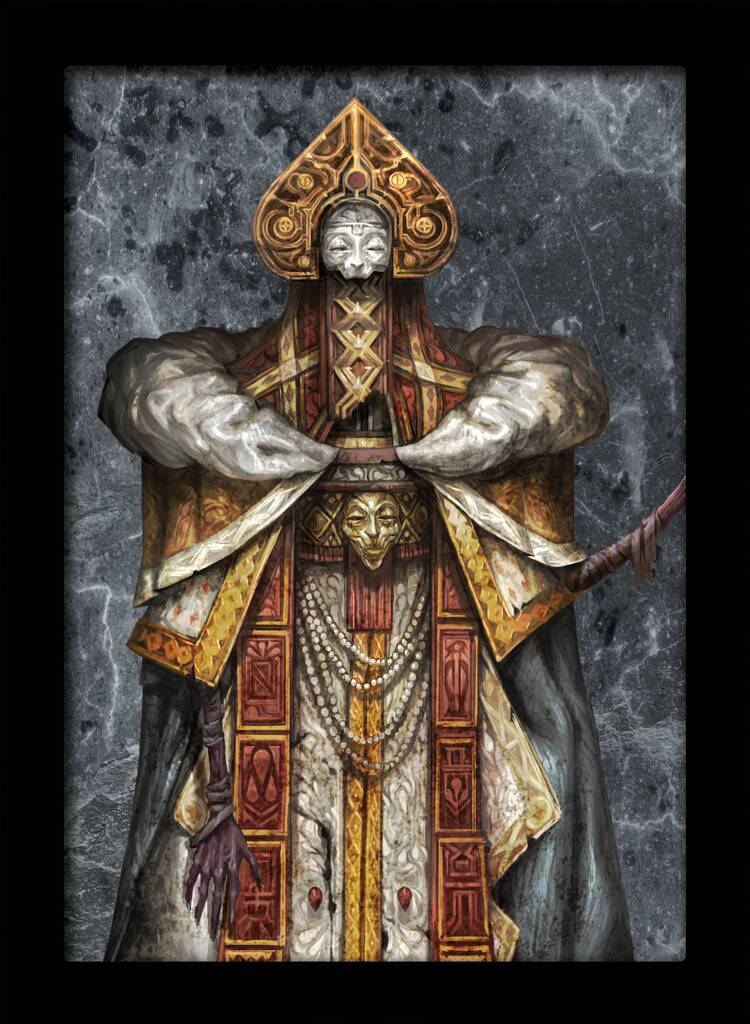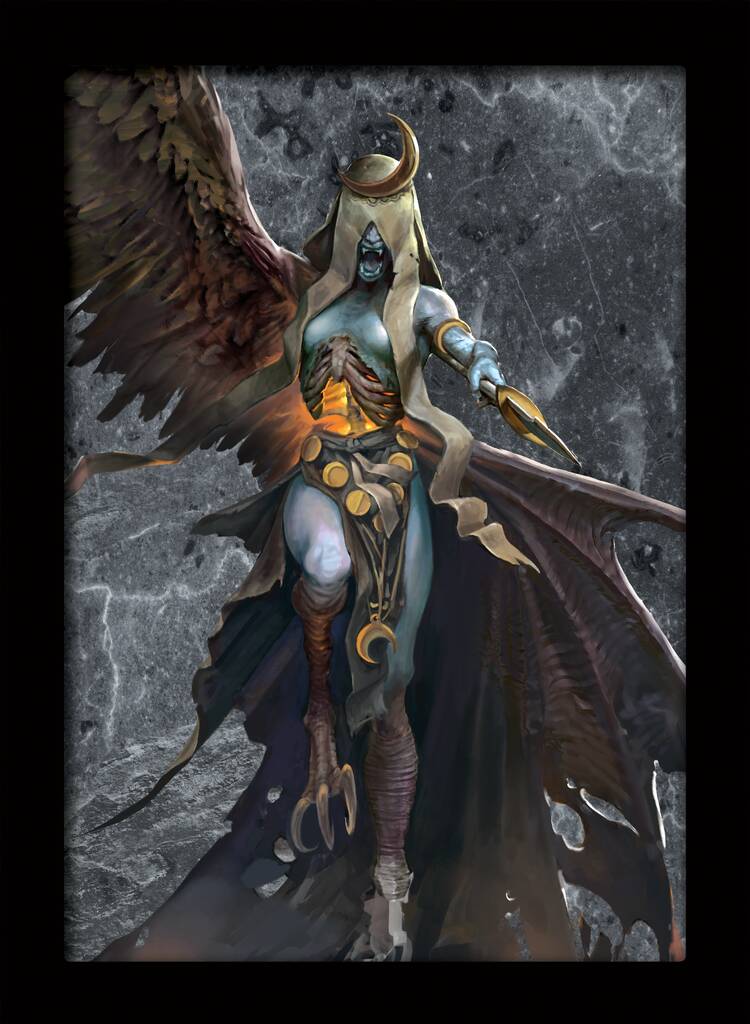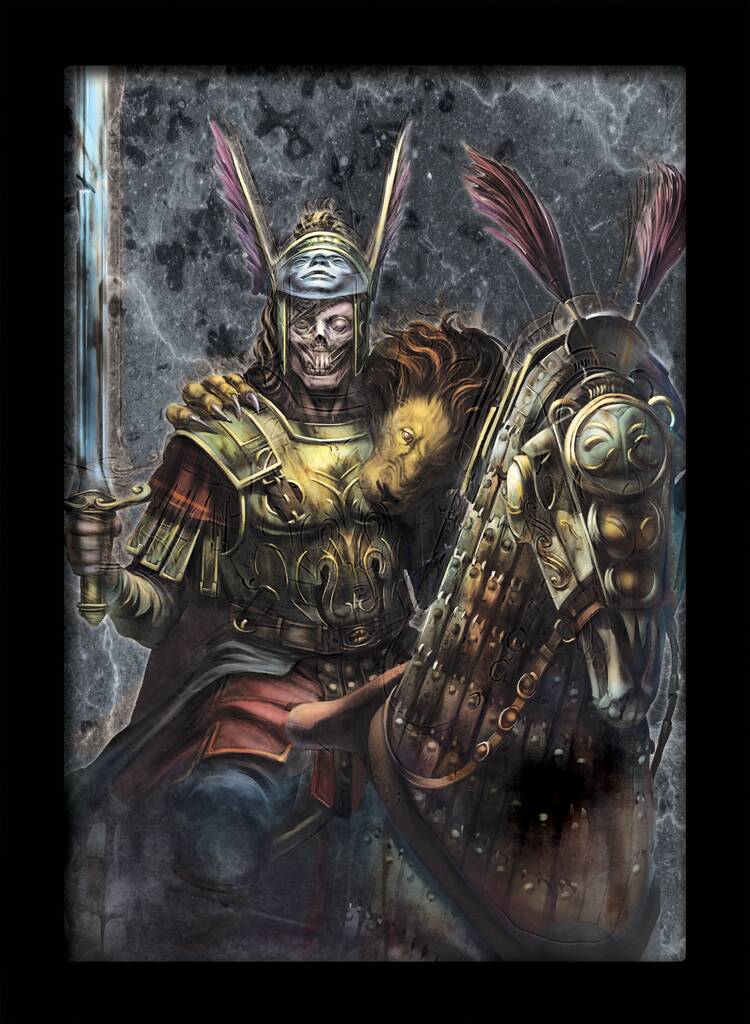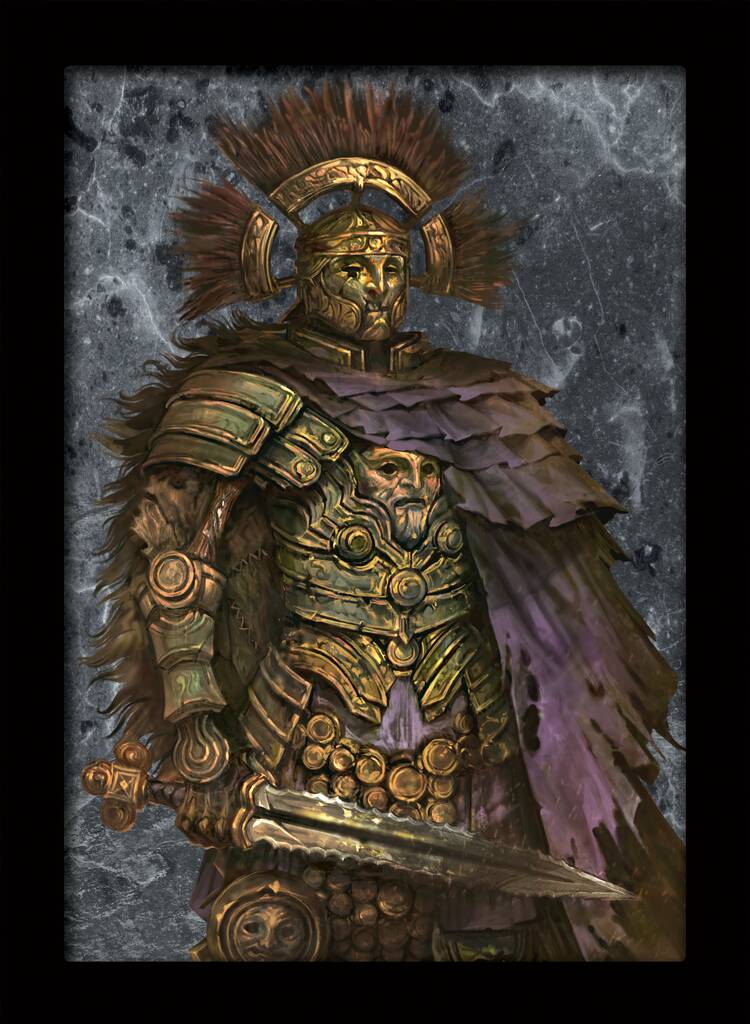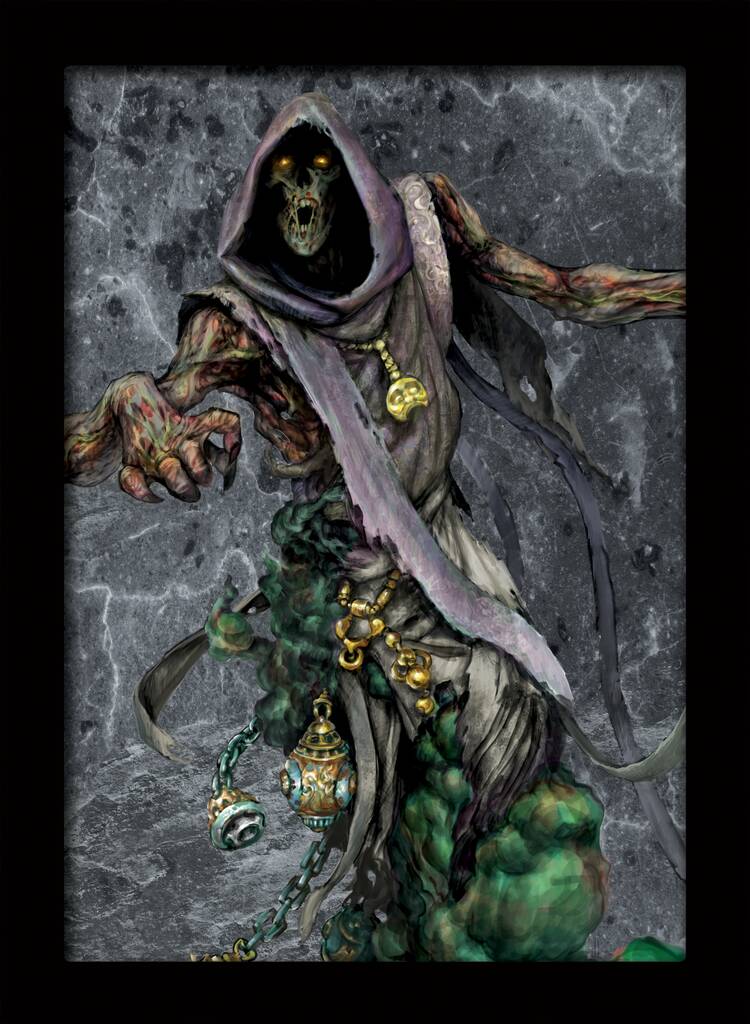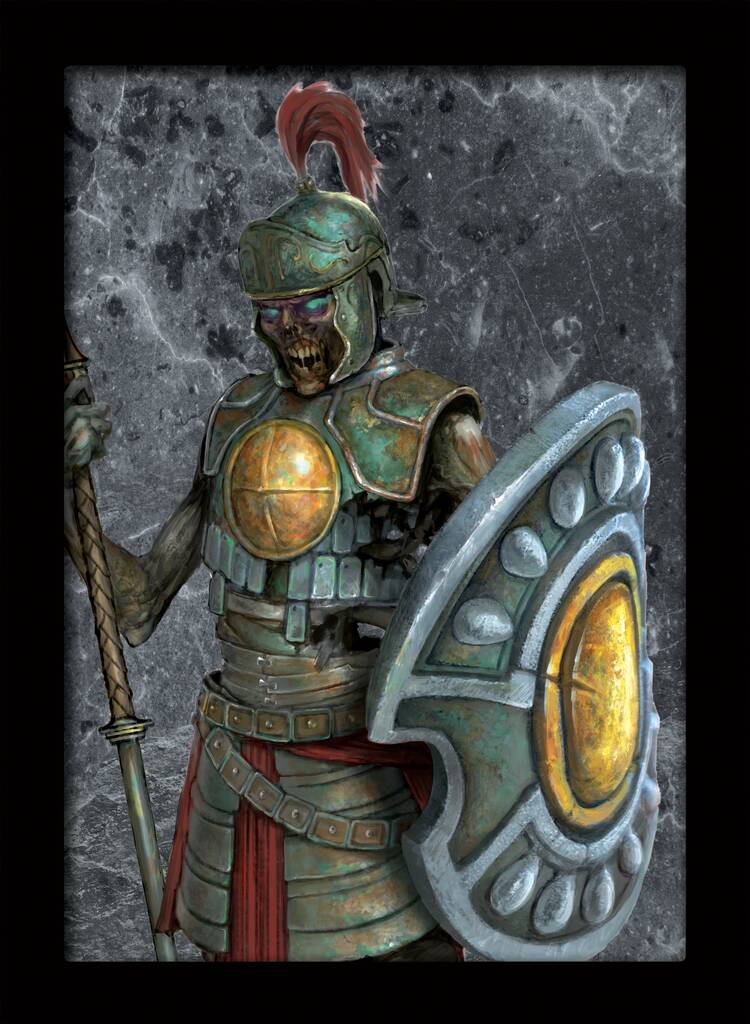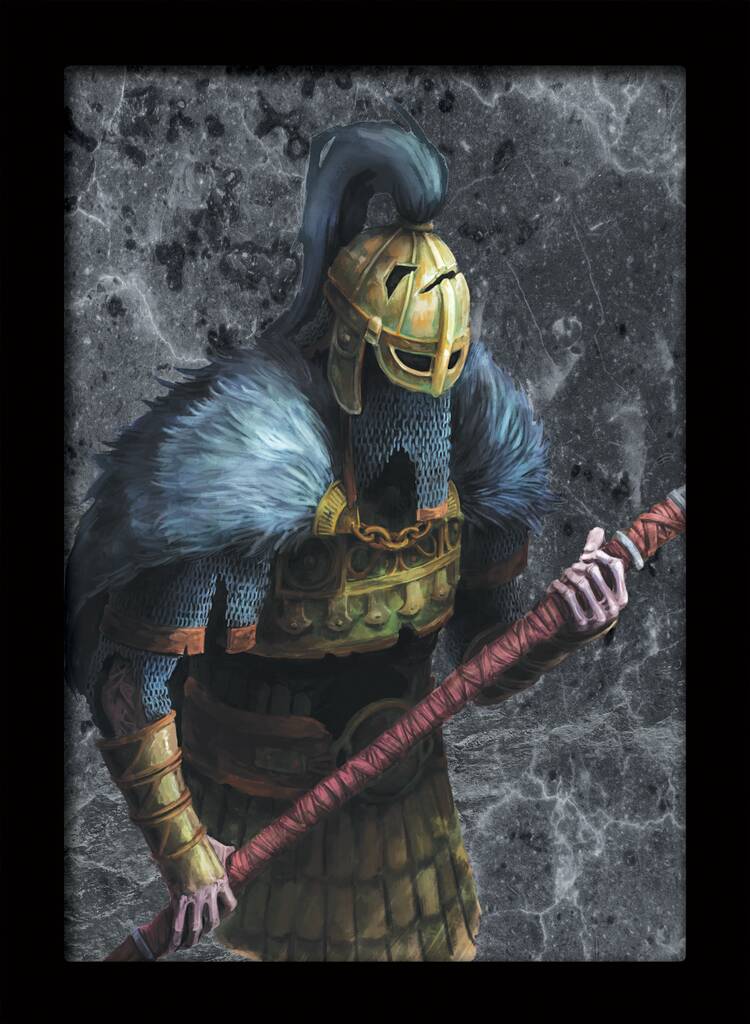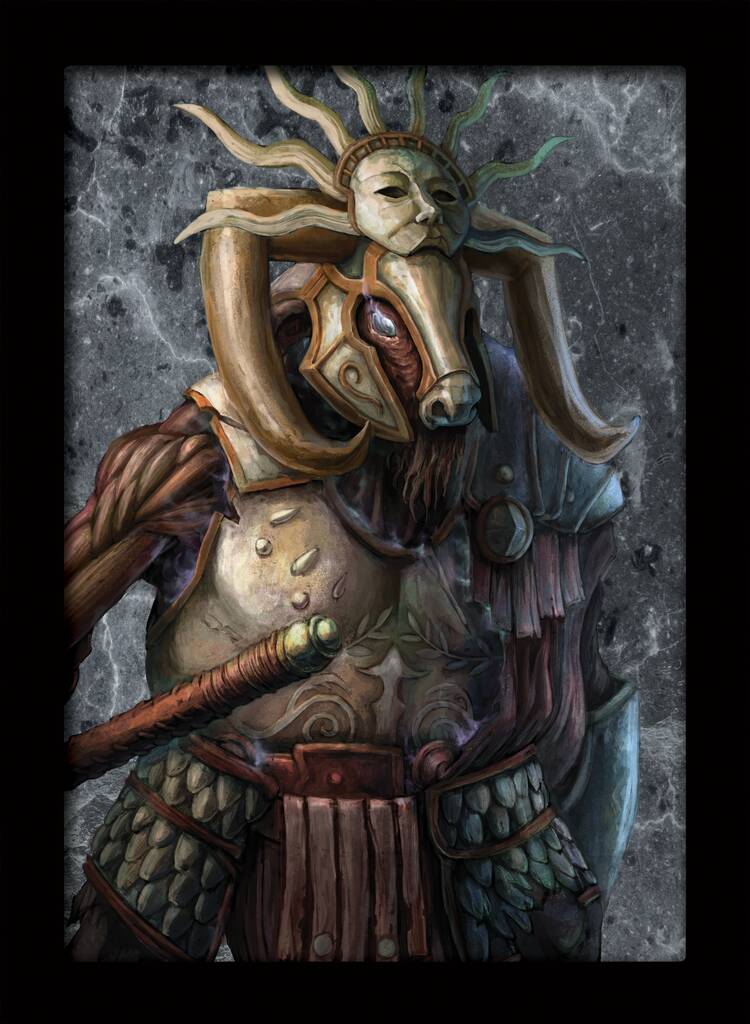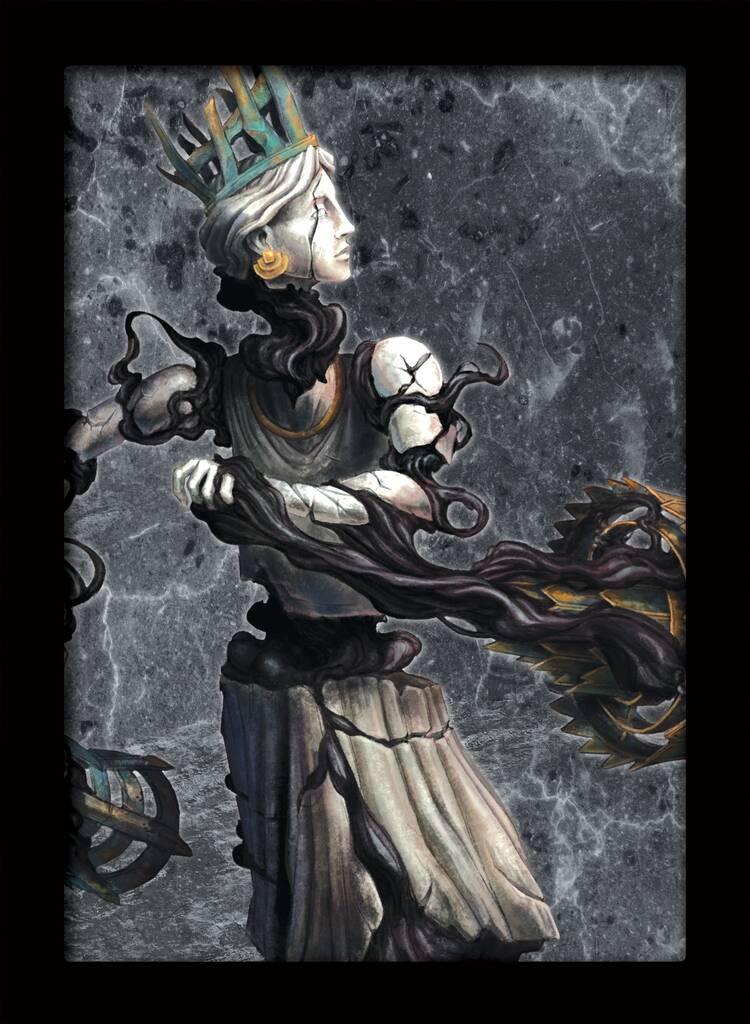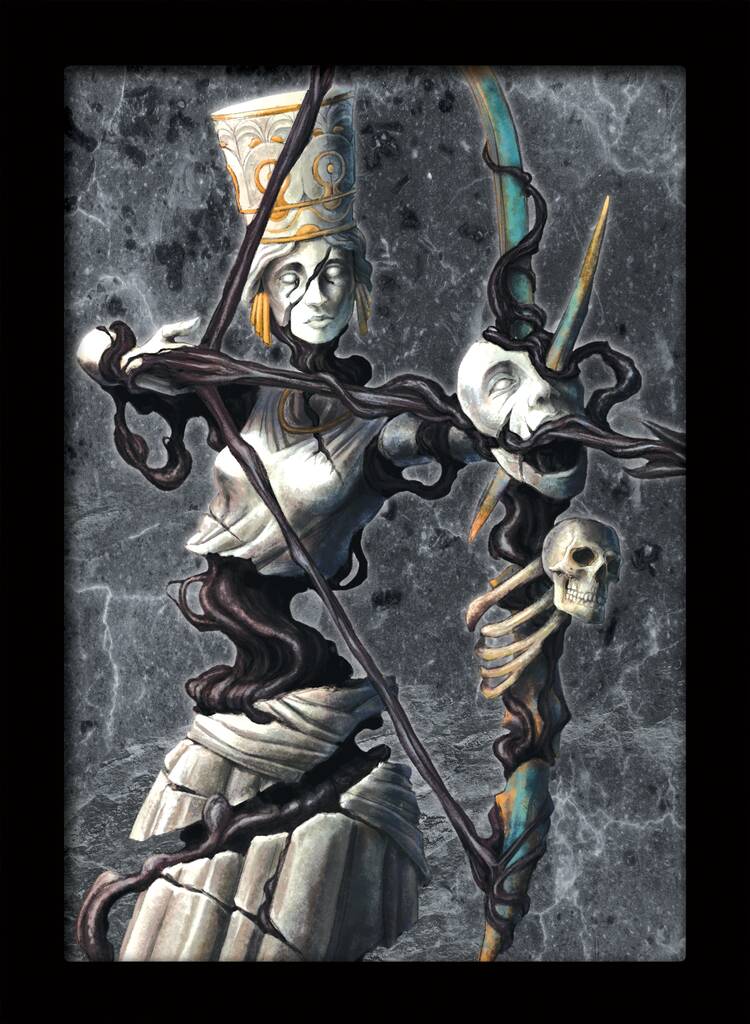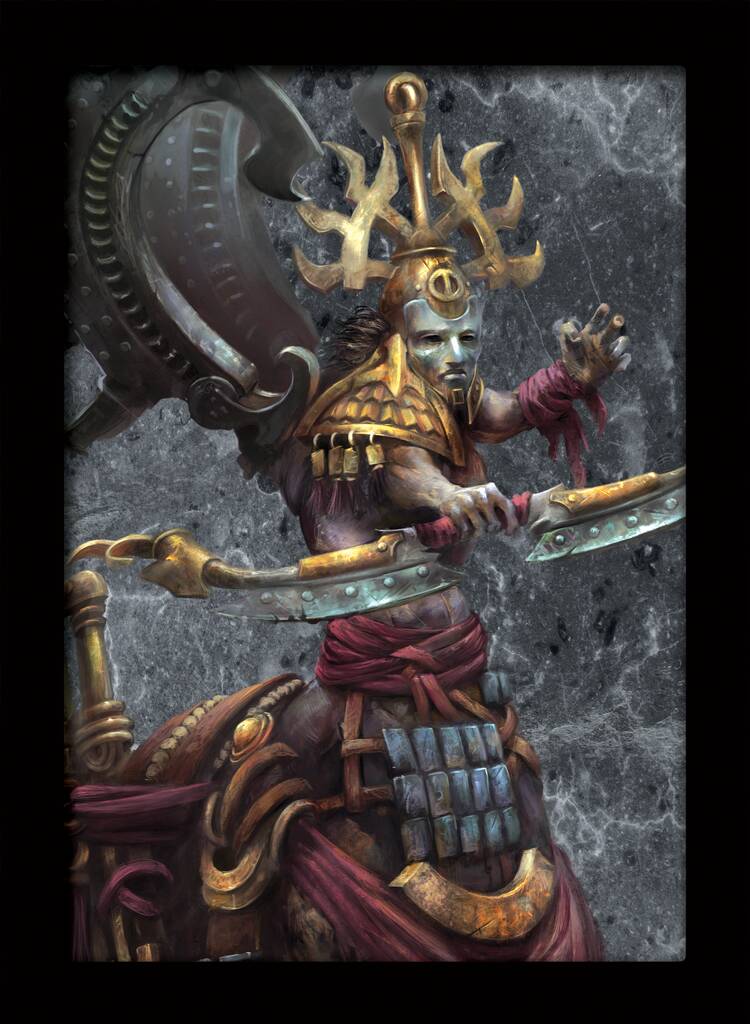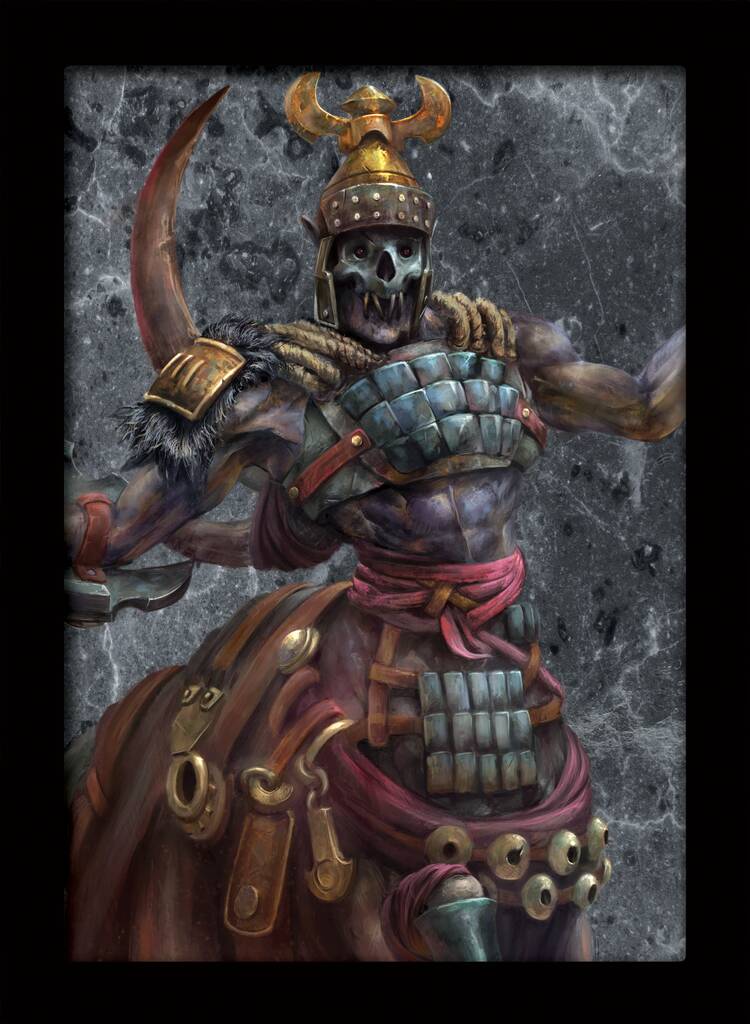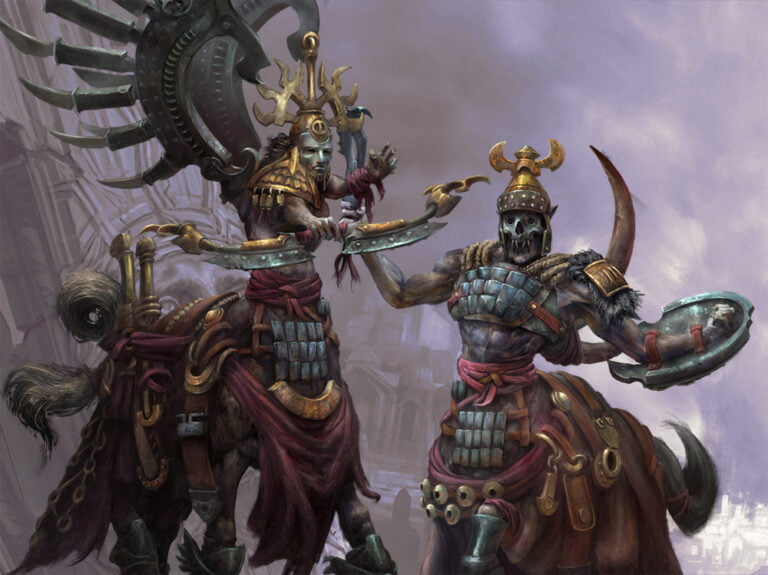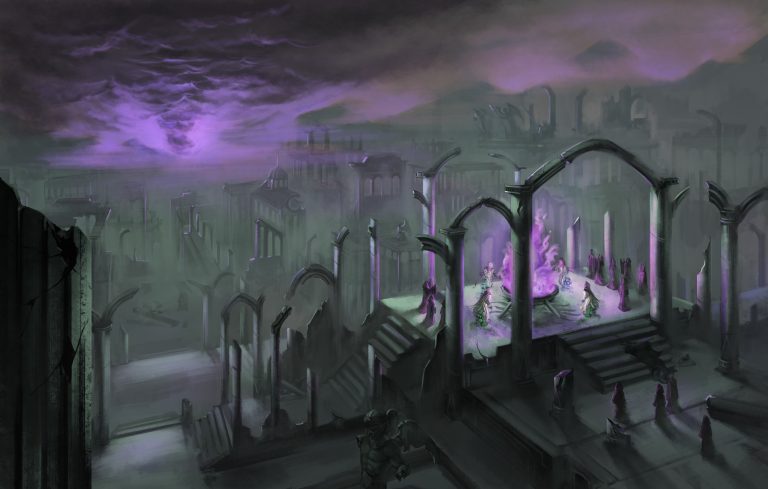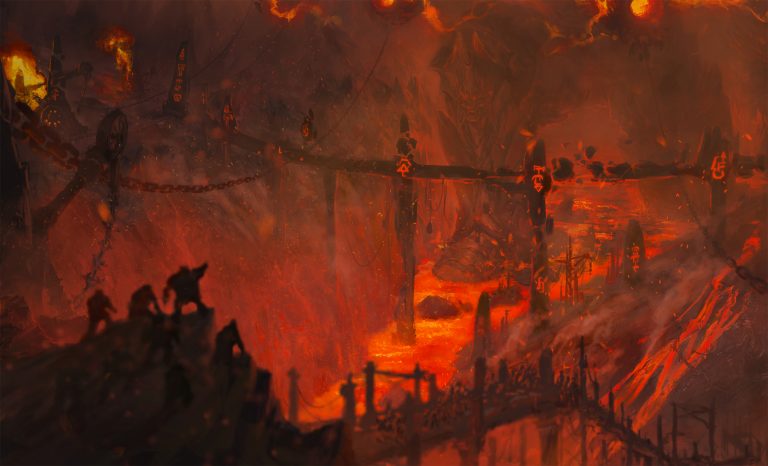Old Dominion

Few, if any, have ever truly understood what happened to Hazlia when he Fell. What is known is that Humanity’s Allfather fell into the prison of Death – but was not stopped. And, like those sworn to him in life, Hazlia returned, as did his Dominion.
“We bring only peace. Love Us. We do. Return to Us. We did to you. Accept Our offer.”
“What is your offer?”
Once again, the answer came from all, only this time it was no whisper, it was no sigh. It was a statement, a promise, certain and inescapable, echoing like distant thunder slowly reaching us in the confines of the pass: “Death.”
Behind the golden mask, I felt the smile of the Keeper.
“We bring only peace,” it repeated.
– From the Memoirs of Squire Jeorg of Riim
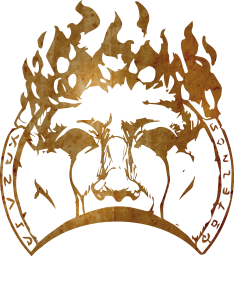
![]() A common misconception amongst modern historians and their students is that the title of Dominion refers to the Dominion of Man. It most certainly does not. The original inhabitants referred instead to the Dominion of Hazlia, the Pantokrator, God of Mankind. And with his Fall the Dominion ended – but did not die.
A common misconception amongst modern historians and their students is that the title of Dominion refers to the Dominion of Man. It most certainly does not. The original inhabitants referred instead to the Dominion of Hazlia, the Pantokrator, God of Mankind. And with his Fall the Dominion ended – but did not die.
Far to the east of the Hundred Kingdoms, past the Claustrine Mountains and the desert wasteland beyond it, lie the heartlands of the old Dominion. Once a continent-spanning power, the legions of the old Dominion were powerful enough to threaten even the elder races of the Dweghom and the Spires into acquiescence, or at least a semblance of it.
Past the once teeming valleys and fertile plains of the Heartlands lie the river valleys upon which Capitas, the greatest city of humanity ever built, was founded. And it is here, amongst the ruins of the holiest of cities of man, that the remnants of Hazlia fell.
Wounded unto death, but immortal and driven to a towering rage by the betrayal of his subjects, Hazlia was pushed beyond the limits of despair and rage. In his hubris he sought to end the Old Dominion but was foiled by the sacrifice of another member of the Pantheon: Ninuah, the Mother.
Denied, broken, and driven well past the edge of madness, Hazlia reached out to whatever power could answer his desperate need to avenge himself and punish his betrayal… and one answered. Death, the third Incarnate Soul of Destruction, had been bound beyond the reach of any being, living or dead, but Hazlia now stood on the threshold of both and could hear his call. Bending all his divine might, Hazlia was able to carve his way into Death’s prison as he Fell.
What happened within that forsaken realm is beyond the understanding of mortals and immortals alike, but, from the unholy fusion of those two polar Primordial elements, an unholy amalgam was born: Undeath.
Animate but unalive, aware but un-souled, a new Primordial paradigm was born. Its rage-filled birth cry infused the thousands upon thousands of dead in Capitas and the Old Dominion beyond with a fraction of his essence granting them a ghastly unlife. The spiritual connection the deceased had with Hazlia made this transfer not just possible, but remarkably easy. In fact, this birth cry was so powerful and uncontrollable that Hazlia poured too much of his essence into it, becoming little more than a single directive that lived within each of his undead creations: slay the living.
Almost no records of the butchery that followed exist outside of the most secret vaults of the Order of the Ashen Dawn. What little knowledge of this period exists is embedded into the dark myths and legends of the Rus, the last of mankind to flee the Old Dominion and cross the Claustrine Range to freedom. They alone, amongst all the remnants of mankind, were forced to face the untrammeled horror of Hazlia’s rage and despair made manifest and their myths, legends, and cultural outlook reflect this.
Through the selfless sacrifice of the Last Legion and the last remaining god of the Triumvirate, Cleon, Hazlia’s horde was defeated, but a primordial power as old and vast as a Horseman, even a corrupted one, cannot be defeated, merely contained.
And so it was that Hazlia’s power and his Will were severed. What the legion did with his Will remains the single most closely guarded secret of mankind, but his power has raged unchecked for centuries in the heart of the Old Dominion. In the center of Capitas there is a gigantic pit from which blazes a miles-high beacon of unlight: a powerful beam of dark fire that casts as much shadow as it does light, shrouding the entire city in a hellish glow of dancing shadows. This is the unfettered and unbound essence of Hazlia, fallen god of mankind; it is a corruption unlike anything that ever came before it, and it has sung its siren song for centuries, drawing the mad, the broken, the despairing, and the power-hungry to it like moths to a flame.
Over the centuries, hundreds, if not thousands, of mortals have answered the call. Of these, only a mere handful have survived, and they are the Anointed: the Prophet, the Warlord, the Speaker, the Seer, the Howler, the Keeper, the Branded, the Whisperer, and the Broken. The first whisper of their names is starting to be heard in the lands of man, a whisper that will soon burgeon to become a storm…
Biases of the Great Equalizer
Only fools expected unLife to bring unity. Along with the faithful and everything imbued with faith to Hazlia, the byzantine machinations of the old theocracy were also revived – this time, with an eternity of power and influence there for the taking.
 Final Creed
Final Creed Fallen Pantheon
Fallen Pantheon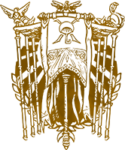 Legions
LegionsThe Final Creed
Even as Hazlia fell, some of his priests led prayers in his name while the panicked population of the city tried to escape. Even as the shockwave tore through Capitas and reduced the city to rubble, they chanted His praise while being torn to pieces by flying rubble and an enraged mob. Even as Hazlia’s un-Birth blanketed the land in a peal of death and darkness, ripping the life from all but the hardiest, they called out his name with reckless abandon, and his Name might be the last thing to pass their lips. Even as Hazlia’s dark will was made manifest and the dead walked once more to slay the living, they cried out his name in joyous communion and somehow managed to survive. They are the Apostles of the Final Creed, the last and most fervent worshipers of Hazlia that ever walked the earth, and their task is not complete.
Shielded from Hazlia’s baleful power by countless meters of rock, a maze of storerooms and dusty workshops lie next to forgotten sepulchers, abandoned mausoleums and long neglected naves carved into living rock. This is where the priesthood of the Final Creed carries on its work of bringing Hazlia’s vision to the world. Once that meant marching with Hazlia’s untold legions and bringing death to any mortal creature that stood in their way, utilizing their divine and sorcerous gifts to complement the unthinking savagery and endless numbers of Hazlia’s unliving tide. With Hazlia’s defeat and partial imprisonment, the Creed retreated to Capitas humbled and broken, settling next to the Pyre, that unceasing torrent of corrupted Primordial power that fountains from the epicenter of the Fall in the center of the dead city. Their leader, his original name lost to time and madness, committed ritual suicide by walking into the Pyre.
Even as their reduced number contemplated oblivion for only a handful had survived to this point, the first of the Pilgrims began to arrive. Driven by need or pulled by madness or faith, a few crazed survivors started trickling into Capitas. Their sanity blasted by the sights they had seen, or perhaps lost well before by the heinous acts they had committed, the Pyre called them from across Eä and they proved a fertile seeding ground for the apocalyptic faith of the Final Creed.
Even so, with the vast majority of the unliving tide defeated and their reduced numbers, the cult was in a trajectory to become a little more than a ghastly footnote in the history of man. All of that changed with the arrival of the Prophet, the first of the Anointed. Stepping forth from the twisted primordial flames of the Pyre, the Prophet rejoined his brethren, forged anew in the unholy furnace of his gods’ impotent rage. Their former leader had cast away all his mortal weakness and become a living vessel of his gods’ power and purpose. For while Hazlia’s will had been bound, his power remained available for those desperate, crazy or faithful enough to claim it.
Gifted with a fraction of Hazlia’s corrupt essence, the Prophet rekindled the dying embers of the Final Creed’s faith. Channeling his newfound powers, the Prophet sought to recreate Hazlia’s undead tide and scour the world clean of sentient life only to find that his powers were no match to those of Hazlia: he could not reanimate more than a scant few thousand corpses.
Years and decades of studies and horrible experimentation followed as the Final Creed sought to appease their dark master’s reincarnation, but progress was slow. Hundreds were sacrificed on the altars to fuel his mad quest for power and their bodies reanimated in a vain attempt to recreate the legions Hazlia once commanded. Having cast off his mortal frailties, the Prophet cared not for how far he pushed his servants, driving the cult to the edge of extinction time and time again. Disgusted by the frail efforts of his mortal followers, the Prophet turned further and further away from them, dedicating himself to his own vile studies and experiments. Despite his best efforts the Prophet was forced to concede while his attunement to his god could grow with time and sacrifice – only those who were sworn to Hazlia in life could be reanimated in death. The Prophet was undeterred, however. He might not be able to follow in his master’s footsteps, but he could certainly complete his great undertaking. It would simply take time… time he now had.
Returning to his followers, the Prophet was shocked to discover that he was no longer the only power in Capitas. Others had taken advantage of his long sojourn into the dark secrets of mortality and divinity and usurped a portion of his god’s power, twisting it to their end. Where once he alone commanded the baleful power of Hazlia, others now dared to tread.
Adding insult to injury, his harsh treatment of the Final Creed and subsequent abandonment had left the cult ripe for treason and sedition. Many of his favored followers had cast their lot with these usurpers. While he alone remained the true master of these dark arts, his enemies now benefited from years of careful research and dark secrets he alone had been privy to. Enraged beyond reason, the Prophet marshaled his forces to take down these usurpers, these Anointed, and reclaim his primacy as Hazlia’s Chosen.
The war that raged in Capitas and the dark deserts beyond was the stuff of nightmares that thankfully no sane mortal was forced to witness. Undead legions marched upon each other and clashed for days on end, their bodies as tireless as their masters’ spite. At first the Prophet was successful and managed to bring down a few of the Anointed, fueling his power with their own.
But his resources had been stretched thin. Maintaining his control over Capitas and his own trove of suitable cadavers and bodies was no match for the reanimated Legions his opponents could marshal from the burial grounds scattered across the empire. Worse still, the longer the war raged, the more irreplaceable bodies were being lost, and with them the hopes of conquering the mortal realms.
Faced with these dire facts and the united opposition of the remaining Anointed, the Prophet was forced to concede defeat. To preserve his master’s dark legacy the Prophet agreed in desperation to share Capitas and reform the Final Creed. It would now serve all the Anointed equally and share what knowledge and influence it had amassed with all Anointed.
That is how the Final Creed came to take its current form. Today countless servitors labor daily beneath the oppressive oversight of their unliving masters, to uncover more suitable bodies in the forgotten tombs and catacombs of the Old Dominion, to fuel their dark designs. Morticians and sculptors labor together to repair those bodies that were ravaged by time or battle, seeking to restore their function by replacing their lost parts with replacements carefully carved from the very stones of Capitas – stones that have witnessed Hazlia’s darkest slaughter and bathed in his baleful power for centuries. Some go even further, seeking to combine these unholy remnants with the will of his most loyal lost followers to create unstoppable engines of destruction, all to bring their dead god’s will upon the mortal world.
The Fallen Pantheon
The Pantheon of the Old Dominion were once mankind’s greatest allies, a gathering of puissant primordial powers dedicated to fostering a nascent mankind beset by countless perils. While Hazlia led it, he was not always the most powerful entity within it: Kleon, the Lord of Valor, and Ninuah, the Merciful Mother, were entities even older than himself who had, for their own reasons, been benevolent to the stripling race of Man. Intrinsically tied to their aspects, these divinities could not rise as fast or as far as Hazlia who would eventually come to eclipse them.
In time Hazlia became aware that the Trinity was simply not enough to satisfy the ever-growing needs and demands of mankind and so struck a plan to create divinities from the smallest and faintest of the motes’ Creation. Much like himself before Man’s worship, these motes lacked any sentience or direction and merely drifted through the ether. With an intrinsic understanding of divinity and the power of belief, Hazlia quickly set to creating loyal servants and heralds to satisfy the growing demands of his followers. The process, in essence, was simple: all Hazlia had to do was name and define these Celestials and channel a portion of his own power into them. Thus quickened, channeled human faith would rush to them, empowering them and shaping them at the same time, creating the gods that man himself had envisioned under Hazlia’s guiding eye.
Over the course of centuries, the Pantheon became populated with a plethora of angels, saints, and heralds. An entirely new field of theology had to be created merely to attempt to catalogue and name the countless divine servants that crowded the heavens of the Old Dominion: seraphim, cherubim, powers, and saints all toiled together to enact the will of Hazlia upon the world. Depending on their role and importance, these beings could continue growing in power and awareness, becoming minor divinities in their own right, such as Himeros the God of Winter, or Selene the Lady of Secrets and the Moon, but always subservient to the will of the Pantokrator, Hazlia.
While few are aware of it today, the horrific events of the Fall had a cataclysmic effect on the Pantheon. As the ritual of the Sorcerers reached its zenith, Hazlia became aware of their efforts and bent every effort and means he had to ensure their destruction. Almost the entire Pantheon was unleashed against these upstart humans who sought to attack their god, but to no avail: centuries of familiarity and worship had armed the sorcerers with all the information they needed to defeat their celestial foes. Countless died in the opening salvoes of the conflict and hundreds more died to no avail before the ritual was complete. Those few who survived, often the most powerful and aware, perished in the immediate aftermath of the casting as Hazlia called on their power in an attempt to resist the fate the human sorcerers had unleashed on him. Broken winged angels tumbled from the heavens even as sacred statues and shrines cracked and collapsed under the divine onslaught and their drained, inanimate husks rained down on Capitas for hours before Hazlia was overpowered and cast down from heaven.
For those few celestials who survived the Fall, an even darker fate was reserved: the Un-Birth. As Hazlia consumed and was consumed by Death, the abhorrent primordial energy of that unholy coupling flooded Capitas. Those few celestials who had survived were still linked to Hazlia and were utterly overwhelmed. As the Un-God’s cry echoes across the heavens and the dead stirred to life, the hapless divinities were irredeemably corrupted by the energy that had consumed their God and rose once more as dark reflections of all they once stood for: Himeros the Hungering Dark and Selene Who Stalks the Night are just a few of the horrors birthed in that apocalypse. How many succumbed to this fate, few can say, for they thankfully remain bound to the Pyre and Hazlia’s baleful energies, sparing the world of their horror.
But that innocence is about to be shattered.
As the Anointed prepare for war and the Final Creed stirs, the Fallen Pantheon has finally found the means to escape their captivity. For both these terrifying groups have discovered how to once more call forth the Pantheon to inflict Hazlia’s vision upon the world. As embodiments of Hazlia himself, the Anointed possess enough of Hazlia’s power to sustain a portion of the Pantheon even away from the Pyre, while the Final Creed has discovered that the greatest reliquaries of the old faith and the desecrated bodies of these divinities can be infused to sustain the immortal soul of their occupants with sufficient sacrifice.
Far from mindless automata, the remnants of the Pantheon are possessed of a powerful will and even the Anointed must negotiate with them to secure their services. So the Legions of the Old Dominion march to battle once more, wreathed in the dark and glorious majesty of the members of the Fallen Pantheon. May the Gods have mercy upon us all. For They will not.
The Legions
In the moments that followed the final act of the Fall and the unholy amalgam that was spawned, the Un-God’s maddened sentience reached out to all available vessels; and at the time, those vessels were plenty, for any still and soulless body would do. Countless dead, an empire of them in fact, would be filled with a mockery of life, a twisted vigor of Creation instilled with the emptiness of Death. These endless hosts were for the most part lacking purpose or guidance, the Will of the Un-God too spread and too scattered to offer either, and the life-ending power that existed in that moment of history was contained by its own numbers. But as decades and centuries passed, this explosion of un-life would settle. The new, unnatural primal force would meet its limitations and be reined in by them. The Un-God was shaped partly by faith, the same faith that had shaped Hazlia. Those sworn to him would forever remain vessels of his Will. And in the endless catacombs under Capitas, the Legions of the faithful were waiting with eternal patience.
It is believed that the adoption of the mummification practice began with Hazlia’s semi-primitive clergy during the times of the First Tribe. Inspired by the sealed bodies of Dweghom found in the Hold where Hazlia was discovered, the priests of the fledgling god would research ways in which their bodies could be preserved so that they could serve their god in the afterlife. It is perhaps only natural that the practice would be transferred to all members of the Dominion’s Legions. After all, the origin of the Legions was a group of warrior priests of the First Tribe, equipped by Hazlia’s ingenuity and dedicated to the expansion of His worship. The practice was continued, not simply as a mandate of tradition, but as a core element of the worship of Hazlia.
Chapels dedicated to mummification were built throughout the lands of the Dominion to serve the needs of those officials and warriors stationed there. In Capitas, however, an entire district, the Postern, would be covered by the scent of embalming fluid mixed with the aroma of ceremonial censers. In its center stood the Hall of Orcos, where the Rhadamanthi, priests of the Seer, would perform their gruesome task on the bodies of Legionnaires and the clergy. In its vast rooms, rows upon rows of stone slabs would host countless bodies throughout the centuries of the Old Dominion, its warehouses filled with the extracted organs of the faithful… as well as spare extremities, for the bodies of warriors would often need restoration before preservation.
With the exception of privately built and owned mausoleums by the wealthiest families, all of Hazlia’s faithful were transferred back to Capitas to be set to their final resting place: the Still Lake; a massive, natural complex of caves, filled with underground rivers and lakes, which would eventually become the single largest mausoleum in the history of mankind. Processions for the dead legionnaires, their bodies covered by a sheet and in full armor, would start from Hazlia’s tomb in the center of the Capitas, to the entrance of the Hall of Orcos, placed on a ceremonial boat. From the bowels of the Hall where the Still Lake awaited, they would be taken to their final resting place, tombs specially prepared and enhanced to keep the humidity at bay. It would not be long before the natural caves would be replaced by rows upon rows of these ornate tombs, forever encased in darkness and the soft sounds of water dripping in the still waters.
“To debate His genius is to debate eternity.” This dogmatic paradigm in the lips of Hazlia’s clergy was in the end spat with anger by those fleeing from the destruction of the Fall. Yet, as centuries have passed since the praise of their God’s forethought was filled with bitter irony, one cannot but wonder if this mortal sentiment was shortsighted and premature. Could the Legions awaiting in the Still Lake be part of Hazlia’s plan or, at the very least, a glimpse of his divine foresight?
Many of the few that know such things debate this. Some, respectful of the subtle influence of the Death part in the Un-God, remember their Ovidus: “They will bring you their lost, but know not why.” Even Hazlia could not escape the pull of a true Primordial, they claim. Others saw a simpler perhaps explanation: His Fall, they say, proves that Hazlia was neither all-powerful nor all-seeing and Chance, for better or worse, is her own Mistress. From the very beginning of his Dominion to his own maddened end, Hazlia had made plans within plans, weaved contingencies upon contingencies. What the original plan behind his schemes was, probably no mortal can truly grasp but it simply happened to serve him in his Un-life.

